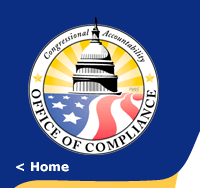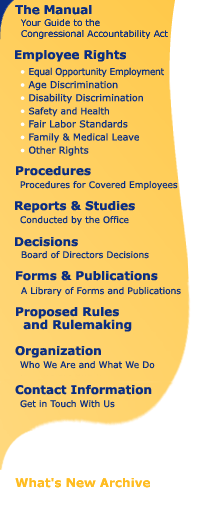 |

|
 |
|||
|
Office Emergency Action
Plans What is an Emergency Action Plan? Emergency Action Plans, or EAPs, are the plans every office must have in place to deal with emergency situations. All employing offices in Congress, including every committee and every personal office of a Member, are required by the Congressional Accountability Act of 1995 to have an EAP. EAPs must be updated regularly, and every employee should be familiar with their contents. EAPs vary in complexity according to the size and needs of the individual office, but all share at a minimum a few common elements:
An EAP should also designate which employee(s) is responsible for coordinating emergency response activities and planning. What Should Every Employee Know About EAPs? As an individual, the first thing you should do to prepare for an emergency is to maintain a basic knowledge of your office’s emergency action plan. Read your office’s EAP and find out who your office emergency coordinator is. If your office does not have one, consider volunteering. Next, be sure you understand how and when you might have to leave your office and how you will know if that is necessary. Most importantly, be sure you know how to exit the building, which exits and stairwells are closest to your office, and where alternate exits are located if the main exits are blocked or impassible. Last, be sure to know where your office will gather once the building is evacuated. Keep in mind that
not all emergencies will call for an evacuation. There may be certain
instances in which it is preferable to stay within the confines
of the office or some other safe area and shelter in place rather
than go outside. Be sure you are familiar with your office’s
plans for such a contingency and where you should go if you must
shelter in place. First and foremost, all Congressional offices are required by law to have a written emergency action plan. It is critical that all offices train their employees and ensure that they are knowledgeable about the office EAP. Each office should also designate an office emergency coordinator (or coordinators) who can keep the EAP up to date, train staff in emergency procedures, and help other staff during an evacuation. Be thorough and comprehensive when planning the office EAP and other emergency policies. Bare bones plans may meet the minimum legal requirements, but there are many different contingencies to consider. For example, in case your office is required to shelter in place rather than leave the building, it is useful to keep a basic supply of food and water on hand for staff. You may also want to maintain contact lists of employees in case staff become separated or need to be contacted at home. Also, consider making backups of critical information (like computer files) and keep them off-site in case an evacuation results in a prolonged absence from your office. Where Can I Find Resources on Emergency Planning and Creating an EAP? For more information on emergency preparedness, contact the Capitol Police and House or Senate authorities. District offices are encouraged to contact local police and emergency preparedness authorities for information about emergency procedures in your area. If your office is in a Federal or state building, you can also contact the General Services Administration (GSA) or the state agency responsible for your facility. The Capitol Police can serve as a resource for more general advice and assistance. For more information on writing an EAP, contact the Office of Compliance, or go to our access our online instructions for writing an EAPs. We also have a form-fillable template that allows you to quickly customize a plan for your office.
|
|
||